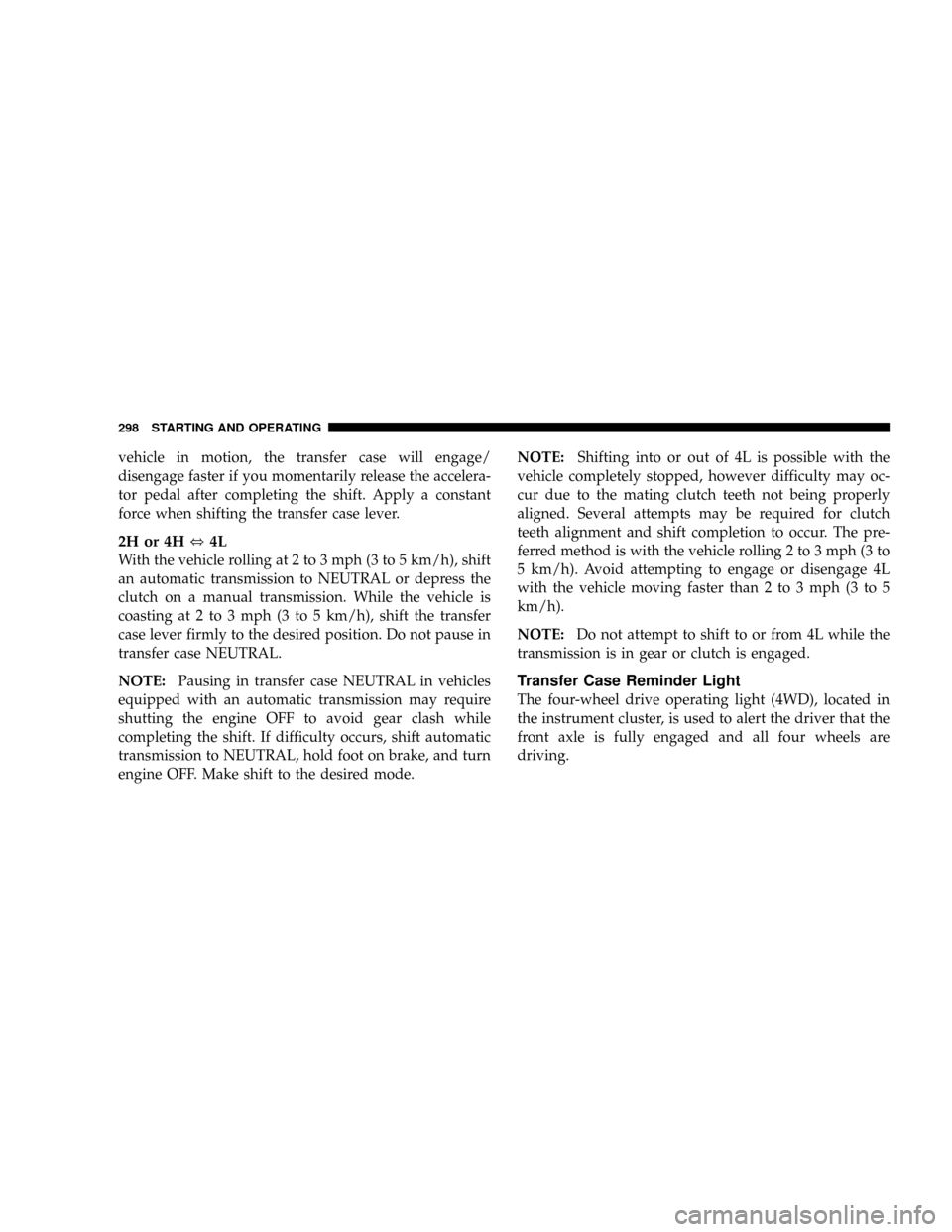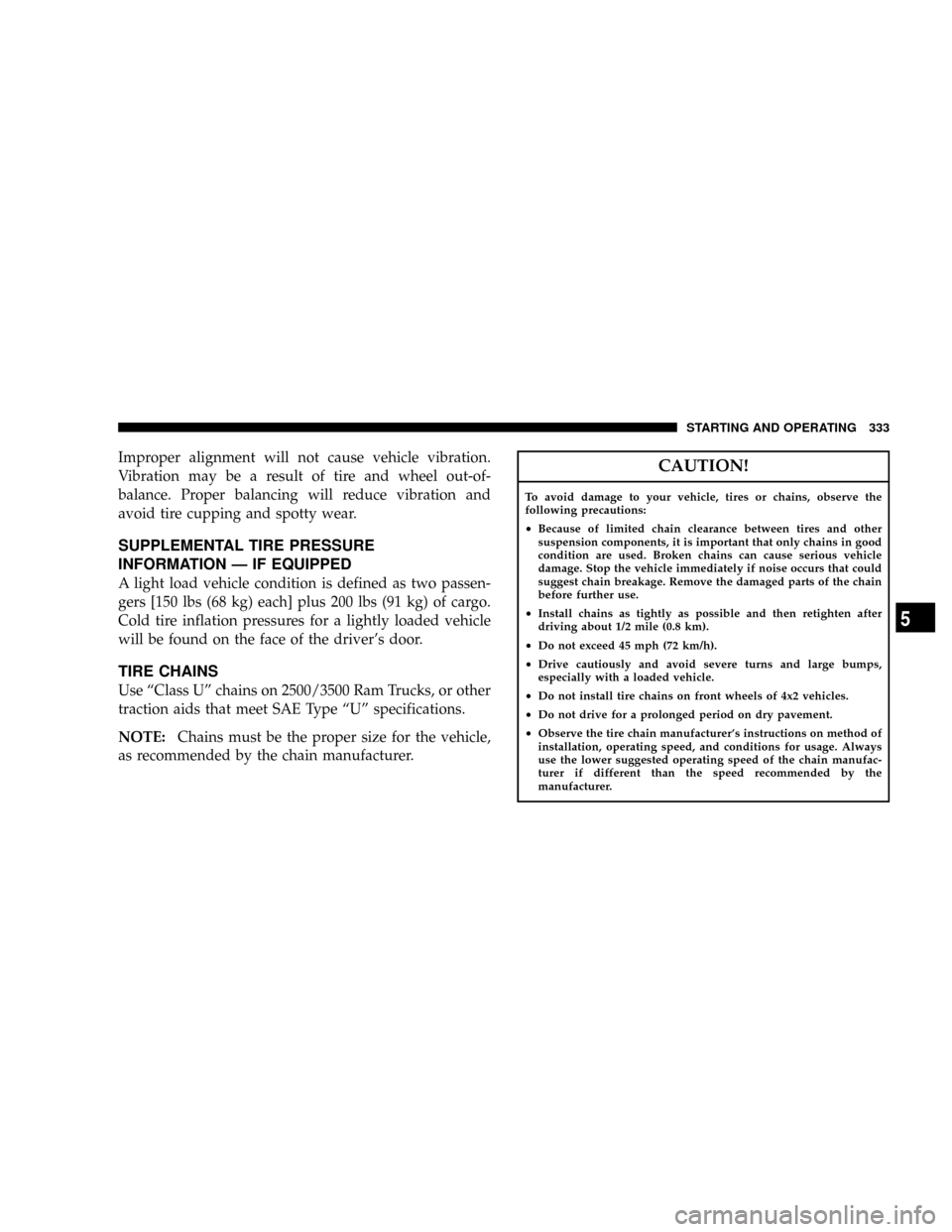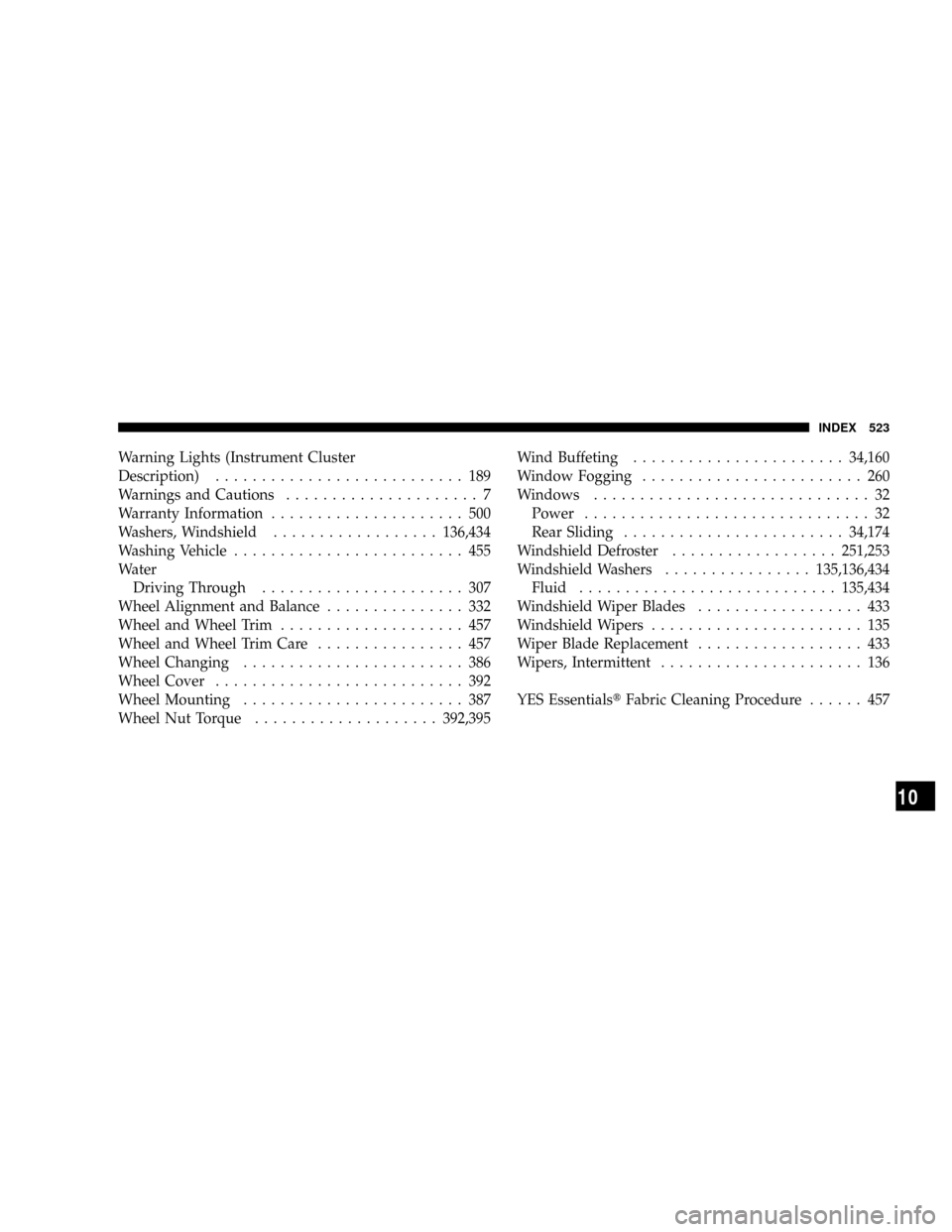2008 DODGE RAM 3500 DIESEL wheel alignment
[x] Cancel search: wheel alignmentPage 267 of 527

NTire Identification Number (TIN)..........319
NTire Loading And Tire Pressure...........320
mTires Ð General Information...............324
NTire Pressure.........................324
NTire Inflation Pressures.................325
NRadial Ply Tires......................327
NCompact Spare Tire Ð If Equipped.........328
NLimited-Use Spare Ð If Equipped.........328
NTire Spinning........................329
NTread Wear Indicators..................330
NLife Of Tire.........................330
NReplacement Tires.....................331
NAlignment And Balance.................332mSupplemental Tire Pressure Information Ð If
Equipped............................333
mTire Chains...........................333
mSnow Tires...........................335
mTire Rotation Recommendations............335
NDual Rear Wheels.....................337
mTire Pressure Monitor System (TPMS) Ð
If Equipped...........................338
NTire Pressure Monitor System (TPMS) ªLight
Loadº Reset Switch Description ±
If Equipped.........................341
NTire Pressure Monitor System Components . . . 344
NGeneral Information...................347
mEngine Runaway.......................347
STARTING AND OPERATING 265
5
Page 300 of 527

vehicle in motion, the transfer case will engage/
disengage faster if you momentarily release the accelera-
tor pedal after completing the shift. Apply a constant
force when shifting the transfer case lever.
2H or 4H,4L
With the vehicle rolling at 2 to 3 mph (3 to 5 km/h), shift
an automatic transmission to NEUTRAL or depress the
clutch on a manual transmission. While the vehicle is
coasting at 2 to 3 mph (3 to 5 km/h), shift the transfer
case lever firmly to the desired position. Do not pause in
transfer case NEUTRAL.
NOTE:Pausing in transfer case NEUTRAL in vehicles
equipped with an automatic transmission may require
shutting the engine OFF to avoid gear clash while
completing the shift. If difficulty occurs, shift automatic
transmission to NEUTRAL, hold foot on brake, and turn
engine OFF. Make shift to the desired mode.NOTE:Shifting into or out of 4L is possible with the
vehicle completely stopped, however difficulty may oc-
cur due to the mating clutch teeth not being properly
aligned. Several attempts may be required for clutch
teeth alignment and shift completion to occur. The pre-
ferred method is with the vehicle rolling 2 to 3 mph (3 to
5 km/h). Avoid attempting to engage or disengage 4L
with the vehicle moving faster than 2 to 3 mph (3 to 5
km/h).
NOTE:Do not attempt to shift to or from 4L while the
transmission is in gear or clutch is engaged.
Transfer Case Reminder Light
The four-wheel drive operating light (4WD), located in
the instrument cluster, is used to alert the driver that the
front axle is fully engaged and all four wheels are
driving.
298 STARTING AND OPERATING
Page 334 of 527

WARNING!
²Do not use a tire, wheel size or rating other than that
specified for your vehicle. Some combinations of
unapproved tires and wheels may change suspension
dimensions and performance characteristics, result-
ing in changes to steering, handling, and braking of
your vehicle. This can cause unpredictable handling
and stress to steering and suspension components.
You could lose control and have an accident resulting
in serious injury or death. Use only the tire and
wheel sizes with load ratings approved for your
vehicle.
²Never use a tire with a smaller load index or capacity,
other than what was originally equipped on your
vehicle. Using a tire with a smaller load index could
result in tire overloading and failure. You could lose
control and have an accident.
²Failure to equip your vehicle with tires having ad-
equate speed capability can result in sudden tire
failure and loss of vehicle control.
CAUTION!
Replacing original tires with tires of a different size
may result in false speedometer and odometer
readings.
Alignment and Balance
Poor suspension alignment may result in:
²Fast tire wear.
²Uneven tire wear, such as feathering and one-sided
wear.
²Vehicle pull to right or left.
Tires may also cause the vehicle to pull to the left or right.
Alignment will not correct this condition. See your
authorized dealer for proper diagnosis.
332 STARTING AND OPERATING
Page 335 of 527

Improper alignment will not cause vehicle vibration.
Vibration may be a result of tire and wheel out-of-
balance. Proper balancing will reduce vibration and
avoid tire cupping and spotty wear.
SUPPLEMENTAL TIRE PRESSURE
INFORMATION Ð IF EQUIPPED
A light load vehicle condition is defined as two passen-
gers [150 lbs (68 kg) each] plus 200 lbs (91 kg) of cargo.
Cold tire inflation pressures for a lightly loaded vehicle
will be found on the face of the driver's door.
TIRE CHAINS
Use ªClass Uº chains on 2500/3500 Ram Trucks, or other
traction aids that meet SAE Type ªUº specifications.
NOTE:Chains must be the proper size for the vehicle,
as recommended by the chain manufacturer.
CAUTION!
To avoid damage to your vehicle, tires or chains, observe the
following precautions:
²Because of limited chain clearance between tires and other
suspension components, it is important that only chains in good
condition are used. Broken chains can cause serious vehicle
damage. Stop the vehicle immediately if noise occurs that could
suggest chain breakage. Remove the damaged parts of the chain
before further use.
²Install chains as tightly as possible and then retighten after
driving about 1/2 mile (0.8 km).
²Do not exceed 45 mph (72 km/h).
²Drive cautiously and avoid severe turns and large bumps,
especially with a loaded vehicle.
²Do not install tire chains on front wheels of 4x2 vehicles.
²Do not drive for a prolonged period on dry pavement.
²Observe the tire chain manufacturer's instructions on method of
installation, operating speed, and conditions for usage. Always
use the lower suggested operating speed of the chain manufac-
turer if different than the speed recommended by the
manufacturer.
STARTING AND OPERATING 333
5
Page 374 of 527

Before plowing
²
Check the hydraulic system for leaks and proper fluid
level.
²Check the mounting bolts and nuts for proper tight-
ness.
²Check the runners and cutting edge for excessive wear.
The cutting edge should be 1/4 to 1/2 inch above
ground in snow plowing position.
²Check that snowplow lighting is connected and func-
tioning properly.
Snowplow Prep Package Model Availability
For Information about snowplow applications visit
www.dodge.com or refer to the current Dodge Body
Builders Guide.
1. The maximum number of occupants in the truck
should not exceed two.2. The total GVWR or the Front GAWR or the Rear
GAWR should never be exceeded.
3. The snowplow prep packages are not available with
the Sport Package.
4. Cargo capacity will be reduced by the addition of
options or passengers, etc.
The loaded vehicle weight, including the snowplow
system, all aftermarket accessories, driver, passengers,
options, and cargo, must not exceed either the Gross
Vehicle Weight (GVWR) or Gross Axle Weight (GAWR)
ratings. These weights are specified on the Safety Com-
pliance Certification Label on the driver's side door
opening.
NOTE:Detach the snowplow when transporting pas-
sengers.
Vehicle front end wheel alignment was set to specifica-
tions at the factory without consideration for the weight
372 STARTING AND OPERATING
Page 522 of 527

Starting Procedures...................... 268
Starting Procedures (Diesel Engines).......... 268
Steering
Linkage............................. 432
Power...........................315,431
Wheel Lock........................... 18
Wheel, Tilt........................... 137
Steering Wheel Mounted Sound System
Controls.............................. 246
Storage, Behind the Seat................... 167
Storage Compartment, Center Seat.........167,168
Storage, Vehicle......................... 464
Storing Your Vehicle...................... 464
Sun Roof.............................. 158
Supplemental Tire Pressure Information........ 333
Synthetic Engine Oil...................277,415
System, Navigation...................... 238
Tachometer............................ 190Tailgate............................... 179
Tether Anchor, Child Restraint.............65,69
Tilt Steering Column..................... 137
Tire and Loading Information Placard......320,333
Tire Identification Number (TIN)............. 319
Tire Markings.......................... 316
Tire Pressure Monitor System (TPMS) Placard
ªHIº (MAX) Load Switch.................. 187
Tire Safety Information.................... 316
Tires ............................78,324,503
Aging (Life of Tires).................... 330
Air Pressure.......................... 324
Alignment........................... 332
Chains.............................. 333
Changing............................ 386
Compact Spare........................ 328
Dual............................337,394
General Information.................... 324
High Speed.......................... 327
520 INDEX
Page 525 of 527

Warning Lights (Instrument Cluster
Description)........................... 189
Warnings and Cautions..................... 7
Warranty Information..................... 500
Washers, Windshield..................136,434
Washing Vehicle......................... 455
Water
Driving Through...................... 307
Wheel Alignment and Balance............... 332
Wheel and Wheel Trim.................... 457
Wheel and Wheel Trim Care................ 457
Wheel Changing........................ 386
Wheel Cover........................... 392
Wheel Mounting........................ 387
Wheel Nut Torque....................392,395Wind Buffeting.......................34,160
Window Fogging........................ 260
Windows.............................. 32
Power............................... 32
Rear Sliding........................34,174
Windshield Defroster..................251,253
Windshield Washers................135,136,434
Fluid............................135,434
Windshield Wiper Blades.................. 433
Windshield Wipers....................... 135
Wiper Blade Replacement.................. 433
Wipers, Intermittent...................... 136
YES EssentialstFabric Cleaning Procedure...... 457
INDEX 523
10